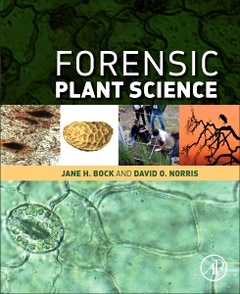Forensic Plant Science
Auteurs : Bock Jane H, Norris David O.

Forensic Plant Science presents chapters on plant science evidence, plant anatomy, plant taxonomic evidence, plant ecology, case studies for all of the above, as well as the educational pathways for the future of forensic plant science.
David O. Norris is Professor Emeritus at the University of Colorado. He obtained his BS from the Baldwin-Wallace University and his PhD from the University of Washington. His broad research areas include environmental endocrinology and forensic botany. In the area of environmental endocrinology, his studies have focused on the neuroendocrine control of thyroid, adrenal, and reproductive functions with special interest in the role of environmental factors that alter the activities of these neuroendocrine systems. In the area of forensic botany, he specializes in the identification of food plants in the stomachs of modern humans with respect to determining time of death.
- Provides techniques, collection methods, and analysis of digested plant materials
- Shows how to identify plants of use for crime scene and associated evidence in criminal cases
- The book’s companion website: http://booksite.elsevier.com/9780128014752, will host a microscopic atlas of common food plants
Date de parution : 01-2016
Ouvrage de 226 p.
19x23.3 cm
Thème de Forensic Plant Science :
Mots-clés :
Forensic Plant Science; Forensic Botany; Plant Anatomy; Plant Ecology; Forensic Science; Accreditation; Angiosperms; Authority; Binomial nomenclature; Biomes; Clandestine grave; Clandestine graves; Code of responsibility; Crime scenes; Daubert trilogy; Diatoms; Dichotomous key; DNA bar coding; Drugs; Ecological landscapes; Ecological sense of place; Ecology; Editation; Eudicots; Gastrointestinal tract; Grasses; Gymnosperms; Herbarium; Monocots; NAS report; NCFS recommendations; Objectivity; Observer effects; Palynology; Phenology; Plant anatomy; Plant ecology; Plant genetics; Plant organs; Plant poisons; Plant taxonomy; Pollen rain; Pollen; Poo prints; Postmortem interval; Ricin; Statistics; Taxonomy; Time of death
